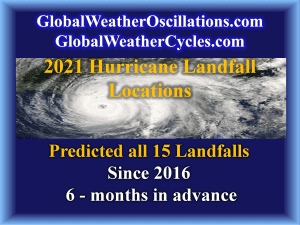TAMPA, FLORIDA, UNITED STATES, March 1, 2021 /EINPresswire.com/ -- During the past five hurricane seasons, the Florida based hurricane prediction org
TAMPA, FLORIDA, UNITED STATES, March 1, 2021 /EINPresswire.com/ — During the past five hurricane seasons, the Florida based hurricane prediction organization Global Weather Oscillations Inc. (GWO) (www.globalweatheroscillations.com) – has consistently predicted months in advance the locations of all 15 hurricanes that made United States landfalls during the period 2016 through 2020. GWO has been producing accurate landfall prediction since 2009 with an accuracy of near 90% during the active 2016 to 2020 seasons.
GWO’s senior research scientist Professor David Dilley says what matters the most – is not how many Atlantic Basin named storms there will be – but instead – having foreknowledge of where the hurricanes will make landfall, and the likely strength of the hurricanes. The ability to predict landfalls in advance is the reason Global Weather Oscillations is the foremost organization when it comes to hurricane predictions. GWO is the only organization that utilizes “ClimatePulse Technology” that tracks historical hurricane cycles and pinpoints future landfall locations months in advance.
GWO is offering “Free” 2021 hurricane outlook webinars at 10:30 am EST on the 9th and 23rd of March, and on April 6th. Find out what to expect in 2021 and become familiar with GWO. You can sign up for a free webinar at GlobalWeatherOscillations.com or GlobalWeatherCycles.com. GWO released their detailed predictions in February for 13 hurricane zones for the United States and Lesser Antilles. They are available in the store at GlobalWeatherOscillations.com.
During the hurricane season, GWO conducts weekly 14-day Outlook webinars to give those in the path of a storm a better chance to prepare. Interactive hurricane tracking webinars are conducted daily for clients when a hurricane is expected to influence any of our 13 prediction zones.
The webinars compare various computer models, ocean temperatures and current atmospheric conditions to GWO’s ClimatePulse predictionss for the 2021 Hurricane Season. Because GWO already knows where the hurricane landfall hot spots are for the season, the webinars provide more accurate path and strength for the impending hurricane – and more preparation time. Some of GWO’s past tracking webinars predicted 6 to 10 days in advance the true path and strength of Category 4 Hurricane Irma in 2017, Category 5 Michael in 2018, Hurricane Dorian staying east of Florida and hitting North Carolina in 2019, and Category 4 Laura in 2020.
Predictions for the 2021 Hurricane Season.
Professor David Dilley says that although there will be fewer named storms than last year’s record-breaking 30 that shattered the long-term average of 11 named storms – the 2021 season will have a near 100% likelihood for being another active and very dangerous hurricane season.
There will be 17 named storms, 8 hurricanes and 3 to 4 major hurricanes. More important than the number of named storms – is the number of United States hurricane landfalls. Last year (2020) saw 6 hurricanes make landfall – and this year will be as dangerous, or even more dangerous than last year. You can expect 4 to 5 United States hurricane landfalls in 2021 – two of which will be dangerous major impact Category 3 to 4 hurricanes – and most of the hurricane landfalls will likely occur in more populated areas than last year – thus making 2021 a dangerous hurricane season for the United States.
Professor Dilley says that “several factors are in place to produce another well above average hurricane season this year”. This includes a 72-year ClimatePulse Enhanced Hurricane Landfall Cycle that produces more United States landfalls – coupled with the lack of an El Niño that tends to subdue a hurricane season, and the continuance of warmer than normal water temperatures in the Caribbean, Gulf of Mexico and Atlantic.
More About ClimatePulse Enhanced Hurricane Cycles.
During Enhanced ClimatePulse Hurricane landfalls Cycles, the number of named storms and United States hurricane landfalls normally rise dramatically, just as they did during past ClimatePulse Cycles that occurred from about 1875 to 1900, 1930 into the 1950s, and as predicted by Professor David Dilley of Global Weather Oscillations – again from 2016 into the 2030s.
Therefore, it is was not unexpected that the number of Atlantic Basin hurricanes became more frequent from 2016 through 2020 and rose from the seasonal average of 6 up to 9, and major Category 3-5 hurricanes increasing from a seasonal average of 2, up to 4 during the current ClimatePulse Cycle. And most importantly, the United States hurricane landfalls rose as expected from a seasonal long-term average of 1.8 per season – up to 4 per season since 2016. GWO stresses that the increases since 2016 are normal and have also occurred during past ClimatePulse landfall cycles.
Professor Dilley says that these enhanced hurricane landfall cycles are induced by naturally occurring electromagnetic ClimatePulse interactions between the earth-moon-sun, and GWO utilizes these interactions in our proprietary ClimatePulse Technology Prediction Models. This is what separates GWO from other organizations.
Global Weather Oscillations officially partnered with the International Hurricane Protection Association (IHPA) in 2017. The IHPA (inthpa.com) is the only professional association comprised of hurricane protection manufacturers, suppliers, contractors and associates dedicated to the protection of life and property from the devastation associated with hurricanes.
Professor David Dilley
Global Weather Oscillations
+1 352-789-4461
dilley@globalweatheroscillations.com
Visit us on social media:
Facebook
Twitter
LinkedIn

